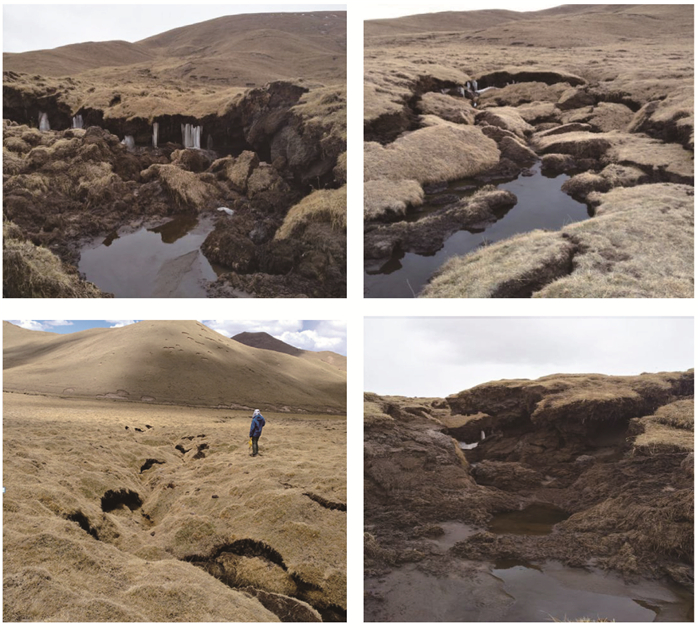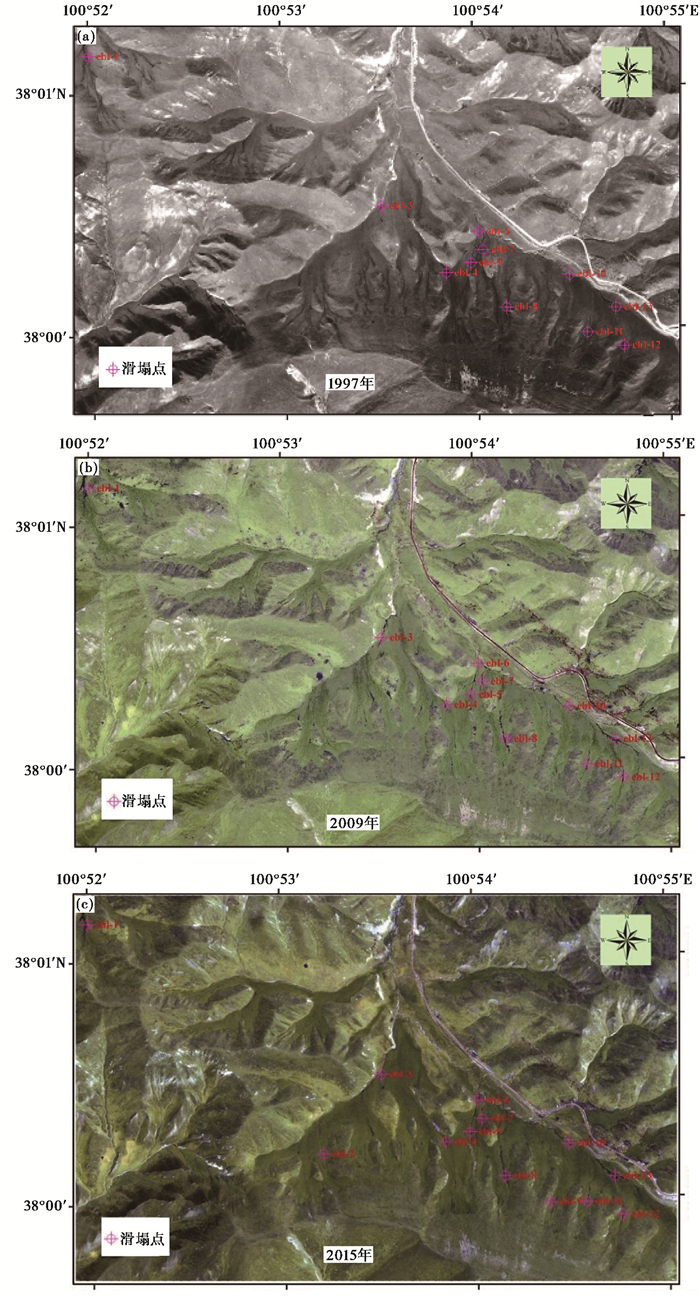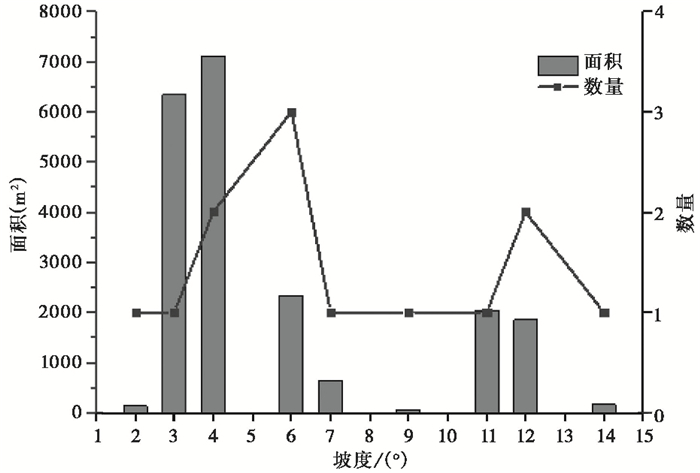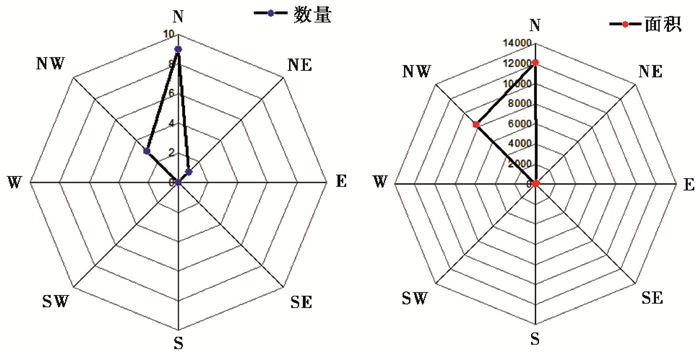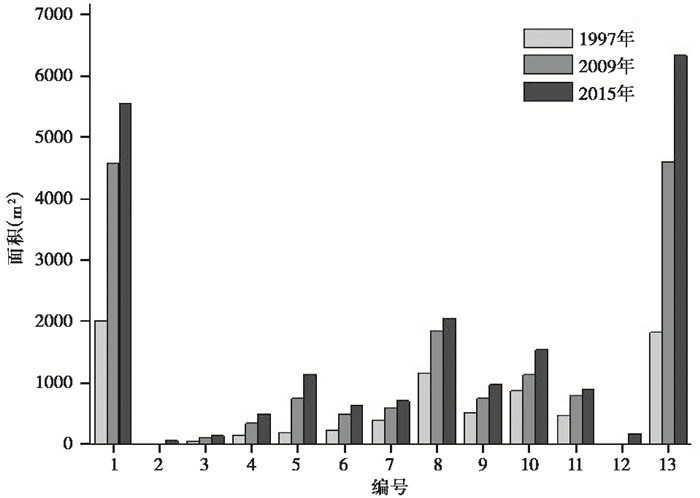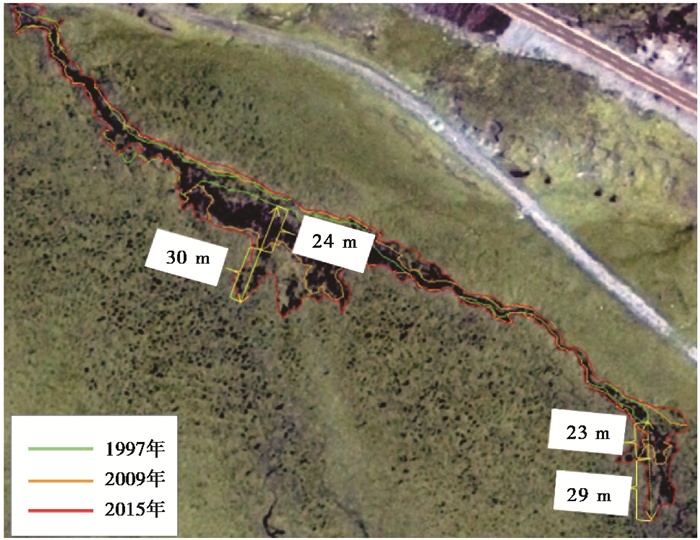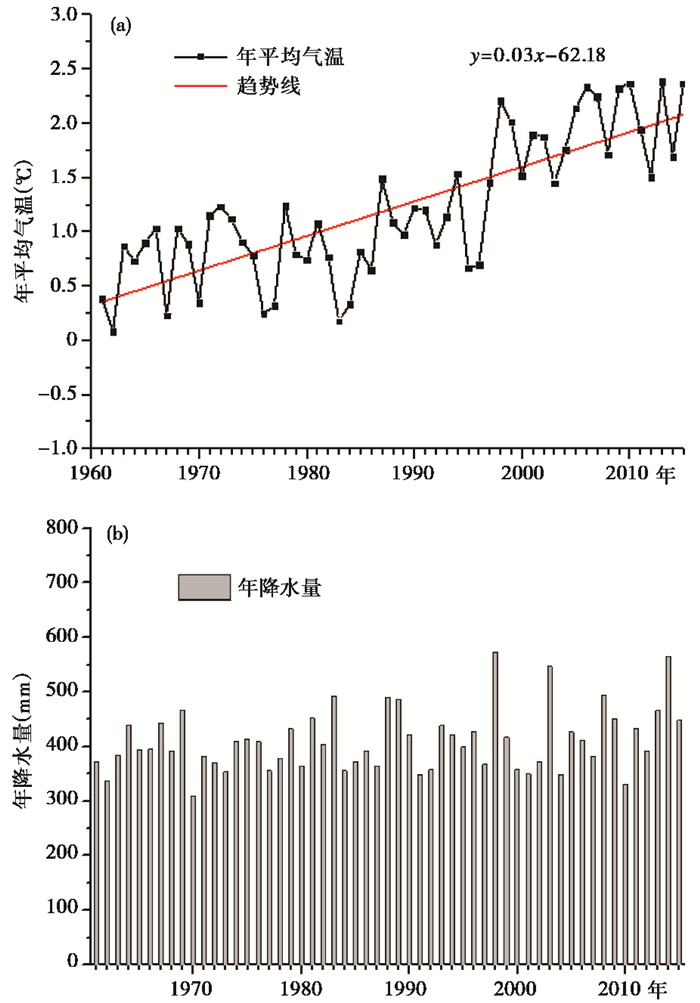Characteristics of thaw slumps over Eboling areas in Qilian Mountains using remote sensing data
-
摘要:
热融滑塌是山地多年冻土退化最直接的表现形式之一,通过解译祁连山俄博岭地区遥感影像,结合实地考察,对俄博岭热融滑塌的空间分布和时间变化进行了研究,明确了热融滑塌的发育特征。结果表明,俄博岭热融滑塌发育活跃,1997~2015年热融滑塌数量增加(11~13个),面积增大(7765~20605 m2),其中1997~2009年面积增加速率为679.9 m2/a,2009~2015年面积增加速率为780.2 m2/a。通过分析热融滑塌景观分布与地形因子的关系,发现俄博岭热融滑塌在海拔3570~3700 m,坡度3°~10°的富冰多年冻土区北向斜坡发育;通过对典型热融滑塌溯源后退速率分析发现,1997~2009年其平均后退速率为2 m/a,2009~2015年平均后退速率为5 m/a,呈明显增大趋势,且其后退速率主要与坡度、地下冰含量和地表径流相关。
Abstract:Thaw slumps or thermokarst in general are the most direct manifestations of permafrost degradation in cold regions. Development of thaw slumps and thermokarst terrains has significant impact on surface energy balance, surface and subsurface hydrological processes, vegetation, soil carbon fluxes, geomorphological processes, and engineering constructions. The objective of this study is to investigate the occurrence and development of thaw slumps and thermokarst terrains in northern Tibetan Plateau during the past few decades. Aerial photographs in 1997 and satellite imageries in 2009 and 2015 were used to analyze creation and expansion of thaw slumps and thermokarst terrains. Field survey was conducted during the summers of 2016 and 2017 to validate the results from aerial photographs and satellite imageries. The results show that there were 13 active thaw slumps over Eboling areas in Qilian Mountains of northern Tibetan Plateau in 2015. Thaw slumps are mainly developed at elevation between 3570 m and 3700 m above sea level on north-facing slopes with slope angles varying from 3°~10°。Based on remote sensing data, the total thaw slump covered area increased from 7765 m2 to 20605 m2 over a period from 1997 through 2015 with an average rate about 713.3 m2/a. However, the rate expansion of thaw slump area was about 679.9 m2/a from 1997 through 2009 and increased to 780.2 m2/a from 2009 through 2015. The retrogressive erosion rate toward the upper slope was about 2 m/a during 1997 through 2009 period and increased about 5 m/a during 2009 to 2015 period. The controlling factors for retrogressive erosion rate were slope angles, ground ice content and surface water runoff.
-
Key words:
- thaw slump /
- thermokarst /
- permafrost
-

-
-
[1] 张廷军.全球多年冻土与气候变化研究进展[J].第四纪研究, 2012, 32(1):27-38. doi: 10.3969/j.issn.1001-7410.2012.01.03 http://www.dsjyj.com.cn/CN/abstract/abstract10567.shtml
Zhang Tingjun. Progress in global permafrost and climate change[J]. Quaternary Sciences, 2012, 32(1):27-38. doi: 10.3969/j.issn.1001-7410.2012.01.03 http://www.dsjyj.com.cn/CN/abstract/abstract10567.shtml
[2] Guo D, Wang H. CMIP5 permafrost degradation projection:A comparison among different regions[J]. Journal of Geophysical Research:Atmospheres, 2016, 121(9):4499-4517. doi: 10.1002/2015JD024108
[3] Wu Q, Zhang Z, Gao S, et al. Thermal impacts of engineering activities and vegetation layer on permafrost in different alpine ecosystems of the Qinghai-Tibet Plateau, China[J]. The Cryosphere, 2016, 10(4):1695-1706. doi: 10.5194/tc-10-1695-2016
[4] Peng X, Zhang T, Frauenfeld O, et al. Spatiotemporal changes in active layer thickness under contemporary and projected climate in the Northern Hemisphere[J]. Journal of Climate, 2018, 31(7):251-266. http://www.wanfangdata.com.cn/details/detail.do?_type=perio&id=8efd5736de11d33ef1fc2e63a984e413
[5] Zhao L, Wu Q B, Marchenko S S, et al. Thermal state of permafrost and active layer in Central Asia during the International Polar Year[J]. Permafrost and Periglacial Processes, 2010, 21(2):198-207. doi: 10.1002/ppp.688
[6] Jorgenson M, Osterkamp T. Response of boreal ecosystems to varying modes of permafrost degradation[J]. Canadian Journal of Forest Research, 2005, 35(9):2100-2111. doi: 10.1139/x05-153
[7] Olefeldt D, Goswami S, Grosse G, et al. Circumpolar distribution and carbon storage of thermokarst landscapes[J]. Nature Communications, 2016, 7:13043. doi:10.1038/ncomms13043.
[8] Kokelj S V, Jorgenson M T. Advances in thermokarst research[J]. Permafrost and Periglacial Processes, 2013, 24(2):108-119. doi: 10.1002/ppp.1779
[9] 秦大河.冰冻圈科学辞典[M].北京:气象出版社, 2014:132-133.
Qin Dahe. Frozen Circle Science Dictionary[M]. Beijing:China Meteorological Press, 2014:132-133.
[10] 吴青柏, 牛富俊.青藏高原多年冻土变化与工程稳定性[J].科学通报, 2013, 58(2):115-130. http://www.wanfangdata.com.cn/details/detail.do?_type=perio&id=kxtb201302002
Wu Qingbai, Niu Fujun. Permafrost changes and engineering stability in the Qinghai-Tibet Plateau[J]. Chinese Science Bulletin, 2013, 58(2):115-130. http://www.wanfangdata.com.cn/details/detail.do?_type=perio&id=kxtb201302002
[11] Mu C, Zhang T, Zhang X, et al. Carbon loss and chemical changes from permafrost collapse in the northern Tibetan Plateau[J]. Journal of Geophysical Research:Biogeosciences, 2016, 121(7):1781-1791. doi: 10.1002/2015JG003235
[12] Mu C, Abbott B, Zhao Q, et al. Permafrost collapse shifts alpine tundra to a carbon source but reduces N2O and CH4 release on the northern Qinghai-Tibetan Plateau[J]. Geophysical Research Letters, 2017, 44(6):8945-8952.
[13] 马立峰.多年冻土地区热融滑塌及其工程危害性的研究[D].兰州: 中国科学院寒区旱区环境与工程研究所硕士论文, 2006: 1-10.
Ma Lifeng. Study on Thaw Slump of Permafrost Regions and Its Engineering Hazard[D]. Lanzhou: The Master's Thesis of Cold and Arid Regions Environmental and Engineering Research Institute, Chinese Academy of Sciences, 2006: 1-10.
[14] Niu F, Luo J, Lin Z, et al. Development and thermal regime of a thaw slump in the Qinghai-Tibet Plateau[J]. Cold Regions Science & Technology, 2012, 83-84(none). doi:10.1016/j.coldregions.2012.07.007.
[15] 周幼吾, 郭东信, 邱国庆, 等.中国冻土[M].北京:科学出版社, 2000:299~226
Zhou Youwu, Guo Dongxin, Qiu Guoqing, et al. Chinese Frozen Soil[M]. Beijing:Science Press, 2000:299~226
[16] 王庆锋, 金会军, 张廷军, 等.祁连山区黑河上游高山多年冻土区活动层季节冻融过程及其影响因素[J].科学通报, 2016, 61(24):2742-2756. http://www.wanfangdata.com.cn/details/detail.do?_type=perio&id=kxtb201624010
Wang Qingfeng, Jin Huijun, Zhang Tingjun, et al. Seasonal freezing and thawing process and its influencing factors of active layer in permafrost regions of the upper reaches of Heihe River in Qilian Mountains[J]. Chinese Science Bulletin, 2016, 61(24):2742-2756. http://www.wanfangdata.com.cn/details/detail.do?_type=perio&id=kxtb201624010
[17] 曹斌, 张廷军, 彭小清, 等.黑河流域年冻融指数及其时空变化特征分析[J].地球科学进展, 2015, 30(3):357-366. http://d.old.wanfangdata.com.cn/Periodical/dqkxjz201503006
Cao Bin, Zhang Tingjun, Peng Xiaoqing, et al. Analysis of annual freezing and thawing index and its temporal and spatial variation characteristics in the Heihe River Basin[J]. Advances in Earth Science, 2015, 30(3):357-366. http://d.old.wanfangdata.com.cn/Periodical/dqkxjz201503006
[18] 牟翠翠, 张廷军, 曹斌, 等.祁连山区黑河上游俄博岭多年冻土区活动层碳储量研究[J].冰川冻土, 2013, 35(1):1-9. http://d.old.wanfangdata.com.cn/Periodical/bcdt201301001
Mu Cuicui, Zhang Tingjun, Cao Bin, et al. Study on active carbon storage in the permafrost regions of the Eboling in the upper reaches of the Heihe River in the Qilian Mountains[J]. Journal of Glaciology and Geocryology, 2013, 35(1):1-9. http://d.old.wanfangdata.com.cn/Periodical/bcdt201301001
[19] 崔之久.初探青藏高原特殊的冰缘现象[J].科学通报, 1980, 25(11):509-512. http://www.cnki.com.cn/Article/CJFDTotal-KXTB198011008.htm
Cui Zhijiu. A preliminary study on the special ice edge phenomenon in the Qinghai-Tibet Plateau[J]. Chinese Science Bulletin, 1980, 25(11):509-512. http://www.cnki.com.cn/Article/CJFDTotal-KXTB198011008.htm
[20] 牛富俊, 程国栋, 赖远明, 等.青藏高原多年冻土区热融滑塌型斜坡失稳研究[J].岩土工程学报, 2004, 26(3):402-406. doi: 10.3321/j.issn:1000-4548.2004.03.021
Niu Fujun, Cheng Guodong, Lai Yuanming, et al. Study on the instability of thaw slump in permafrost regions of the Qinghai-Tibet Plateau[J]. Chinese Journal of Geotechnical Engineering, 2004, 26(3):402-406. doi: 10.3321/j.issn:1000-4548.2004.03.021
[21] 沈宇鹏, 吴艳, 许兆义, 等.多年冻土斜坡稳定性评价方法的探讨[J].铁道标准设计, 2011(3):34-37. doi: 10.3969/j.issn.1004-2954.2011.03.010
Shen Yupeng, Wu Yan, Xu Zhaoyi, et al. Discussion on evaluation method of permafrost slope stability[J]. Railway Standard Design, 2011(3):34-37. doi: 10.3969/j.issn.1004-2954.2011.03.010
[22] 靳德武, 孙剑锋, 付少兰.青藏高原多年冻土区两类低角度滑坡灾害形成机理探讨[J].岩土力学, 2005, 26(5):774-778. doi: 10.3969/j.issn.1000-7598.2005.05.019
Jin Dewu, Sun Jianfeng, Fu Shaolan. Discussion on formation mechanism of two types of low-angle landslides in permafrost regions of the Qinghai-Tibet Plateau[J]. Rock and Soil Mechanics, 2005, 26(5):774-778. doi: 10.3969/j.issn.1000-7598.2005.05.019
[23] 张中琼, 吴青柏.青藏高原多年冻土热融灾害发展预测[J].吉林大学学报(地球科学版), 2012, 42(2):454-461. http://d.old.wanfangdata.com.cn/Periodical/cckjdxxb201202020
Zhang Zhongqiong, Wu Qingbai. Prediction of the Development of Permafrost Thermal Disaster in the Qinghai-Tibet Plateau[J]. Journal of Jilin University(Earth Science Edition), 2012, 42(2):454-461. http://d.old.wanfangdata.com.cn/Periodical/cckjdxxb201202020
[24] Mu C, Zhang T, Wu Q, et al. Carbon and nitrogen properties of permafrost over the Eboling Mountain in the upper reach of Heihe River basin, Northwestern China[J]. Arctic, Antarctic, and Alpine Research, 2015, 47(2):203-211. doi: 10.1657/AAAR00C-13-095
[25] 牟翠翠.多年冻土区温室气体释放的生物地球化学过程[D].兰州: 中国科学院大学博士论文, 2014: 69-86.
Mu CuiCui. Biogeochemical Processes of Greenhouse Gas Release in Permafrost Regions[D]. Lanzhou: The Doctoral Thesis of the Chinese Academy of Sciences, 2014: 69-86.
-



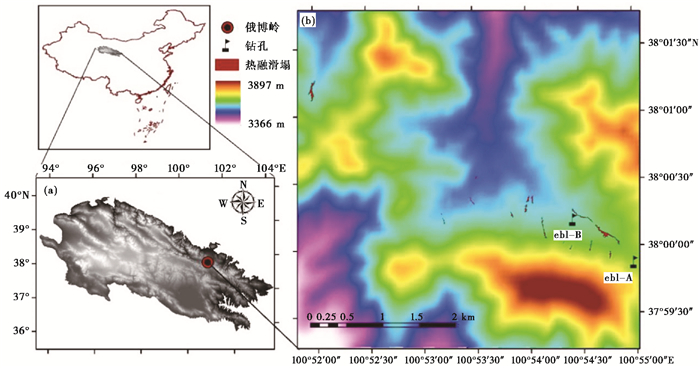
 下载:
下载:
